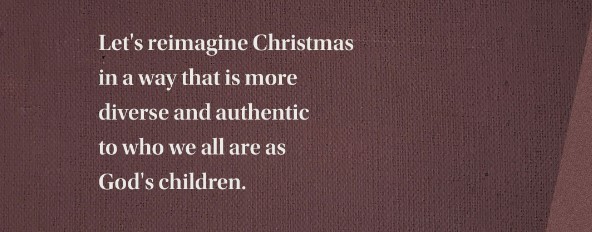Celebrating Christmas as a kid made me feel thoroughly American. Buying a tree, hanging stockings, and having candle lights in the windows were the most connected I ever came to my non-Indian classmates and neighbors. It was the one time of year when we lived our lives in a similar way. All of this, of course, was intentional. My mom, like many immigrants who came to the U.S. in the seventies, had not celebrated Christmas in her home country. Having married an Anglo-American man and raising bicultural kids, however, made this holiday feel like a requirement to assimilate. It didn’t matter if we still ate traditional Indian food or only exchanged a few gifts. The material objects we bought and strung up around our house served as a megaphone to say, We belong.
The older I became, the more I believed the myth of assimilating at Christmastime. December became a month of watching Hallmark movies, The Christmas Story, and It’s a Wonderful Life. I consumed nothing but stories of happy white people, giving gifts and experiencing “the Christmas spirit.” Feasts became larger. Wearing fancy American dresses, doing cookie exchanges and Secret Santas were all musts. I began to believe this was how I was supposed to celebrate the holidays as an Indian American Christian.
But after college I found myself questioning it all: Was I celebrating Christmas to really reflect upon and give thanks for the birth of Jesus, or was I trying to find a place to belong in what often felt like an overtly white American holiday?
I’ve wrestled with this question over the years, and lately, I’ve been trying to get back to my own roots during the Christmas season. I want this time of year to be a season of prayer, gratitude, and devotion to what Christ has come and done, not a chaotic month of presents, decorations, cookies, and parties. More than that, I want to be more connected to who I am as an Indian American woman. What does it mean to celebrate the birth of Jesus in ways that are authentic and meaningful to who I am as a cultural being? How can I celebrate Christmas — and by extension, holidays in general — in ways that incorporate all of who I am as a whole, beautiful, and good?
I’m reimagining my cultural narrative and values and asking myself, How can I make this about Christ? How can I celebrate what Jesus has done and is doing in my cultural story?
Our cultures are a composite of our ethnic story. Part of my story as a bicultural, second-generation, Indian American woman is navigating liminal space, straddling different worlds, and living in the in-between. I’m not fully Asian, nor fully white. My story is a mix of the east and west, of immigration and crossing borders, of farmers and people of the land. And the beauty of the Christmas story is that Jesus came down to earth with me in mind. Jesus the Messiah came to save and rescue me, a caramel-colored woman with all of my joys and pains, all my passions, struggles, and insecurities. Jesus doesn’t overlook me. Jesus doesn’t reject me because I don’t fit into neat racial categories. He sees me in my humanity and loves me as His child.
The simpler I make Christmas, the more I discover this truth.
This year I’m choosing to make Christmas more story-driven. Sure, I might still bake some holiday cookies with my kids, but instead of blasting Christmas classics non-stop and filling our evenings with holiday movies, we’re spending more time talking and reflecting on the good news of Jesus for our Indian-Mexican family. We’re asking each other questions like, “In what ways should the coming of Jesus ’cause great joy’ (Luke 2:10) for us as second-generation Indians and Mexicans? How can we embrace the peace of Jesus as cultural beings this Christmas (Luke 2:14)? And in what ways can we celebrate and give glory to God in distinctly Indian and Mexican ways?”
As you gather with your families around the table, I want to invite you to consider asking the same kinds of questions as it relates to your own ethnic roots. Perhaps there are objects and materials within your ethnic heritage that you can repurpose or create to point to Christ. Maybe the foods and dress of your culture can be thoughtful ways to celebrate Jesus’ birth.
As we take into account our cultural and ethnic roots, may we be like the Israelites of old, recounting memories and sharing stories of what God is doing in our lives. Let’s celebrate and worship Jesus with our own tongue, culture, and values and reimagine Christmas in a way that is more diverse and authentic to who we all are as God’s children.

